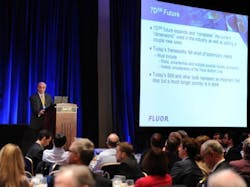Fluor defines the future 7D deliverable without losing sight of real results today
In order to keep my finger on the pulse of the needs of AECO leaders, I attend a good deal of conferences. Many of these conferences cover a variety of topics focused on evolving the design and building process. Topics typically cover technical solutions, process implementations, and standardization means and methods.
Oftentimes, the presenter’s goals are a bit lofty and demand multi-phase approaches to bring about tangible change. That’s why a recent keynote given by Robert Prieto, Senior Vice President of Fluor, was rather refreshing.
Presenting at the Building Innovation 2014 – The National Institute of Building Sciences Annual Conference, Prieto introduced a rather challenging topic, “Life-Cycle Analysis – A 7D Future.” Based on the title alone, it was quite clear that we were in for a mind-expanding keynote, and I was ready to take copious notes.
However, he surprised all of us by starting out his presentation with a simple story. This story illustrated a concept that seemed almost counterintuitive to the event itself. It reminded us that sometimes it’s the simplest details that can bring about real results today—and we shouldn’t overlook them, even as we push to change the future state of project facilitation. As Prieto told this story, I knew I had to blog about it and share it with you.
A few years ago, IBM awarded Fluor with a facilities management contract for a small portion of its data centers. The contract required Fluor to provide ongoing operations and maintenance, space management, health and safety, landscape and grounds, janitorial, and other facility management services.
After the first year or two of the contract, IBM reached out to Fluor to share some impressive results. Turns out, the data centers that Fluor managed had reported a fairly significant savings in overall energy costs. IBM, of course, wanted to understand what Fluor was specifically doing to create these savings. The answer from Fluor was a candid, "We’re not sure."
Fluor quickly launched an investigation into their processes to better understand the drivers behind these cost savings. They evaluated all of their processes and systems and then analyzed the results. What they came to discover was that the answer was not found in their sophisticated FM system, but rather in a simple maintenance list. When they compared their maintenance list against IBM’s, there was one item Fluor had that IBM did not.
Each of the data centers had a white roof, designed to deflect sunlight off of the roof and keep out the heat. Fluor had a line item on their maintenance list to wash the roofs once a month; IBM’s did not.
This seemingly simple task list item had a measurable effect on the energy costs of the building. IBM went on to award them 150 other data centers, then 300 more in 2010.
His point in telling us this story was to remind all of us that there may be simple solutions we can implement today to achieve the results we’re focused on for tomorrow.
Which leads me to ask you: Are there similar experiences you’ve had, implementing a simple change that was the driver for real results outside of the greater objective for large-scale change?
Editor's note: This is sponsored content. The text and image were provided by the sponsor company.
About the Author

Sasha Reed
As Vice President of Strategic Development at Bluebeam, Inc., Sasha Reed collaborates with leaders in the architecture, engineering and construction industry to guide Bluebeam’s technology, partnerships and long-term goals. She joined Bluebeam in 2007 and co-created the Concierge Approach, a distinctly branded process of customer engagement, product feedback and solution delivery to which much of Bluebeam’s success is attributed, and which today is replicated at every organizational level.
Sasha is known industry-wide as a “conversation facilitator,” creating platforms for exchanges necessary to digitally advance the industry, including the BD+C Magazine Digital COM Blog, which she authors and manages. She’s been a featured presenter at numerous national and international conferences, including the 2014 Design-Build Institute of America (DBIA), Federal Project Delivery Symposium and NTI Danish BIM Conference. Sasha also co-chairs the Construction PDF Coalition, a grassroots effort to provide a common industry framework from which to create and maintain construction PDF documents, serves on the City College of San Francisco BIM Industry Council, and is Advisor to the Board of Direction for the National Institute of Building Sciences BuildingSMART Alliance.
